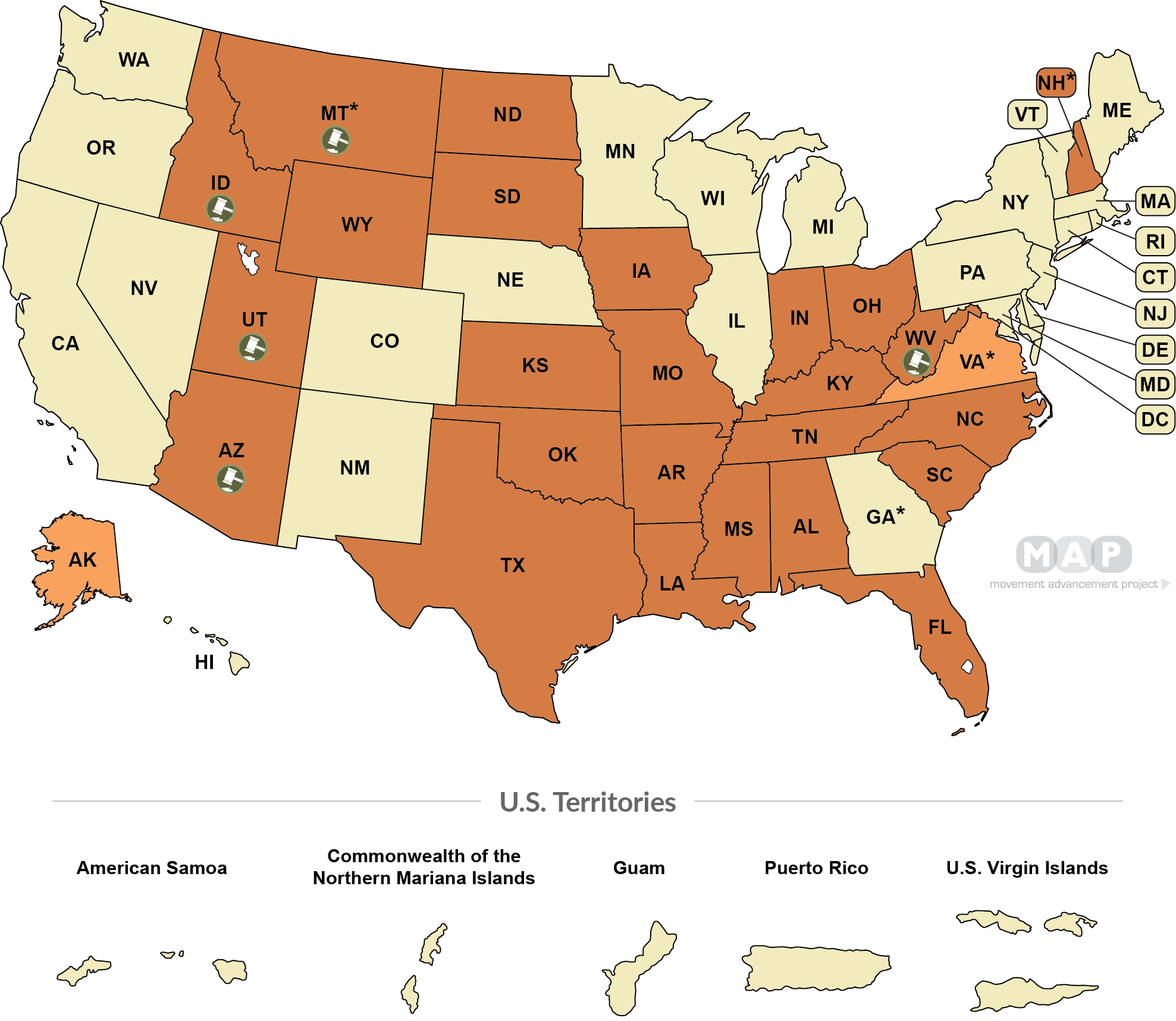Starting around 2020, anti-LGBTQ activists and politicians have introduced – and passed – laws to ban transgender youth from participating in school sports. The scope of these bans can vary across age ranges, but commonly including both K-12 schools and college settings. These laws mean that transgender girls, for example, would not be allowed to participate in sports with other girls. Local schools and state athletic associations already have policies that both protect transgender people and ensure a level playing field for all athletes. In contrast, the policies shown below are blanket bans on transgender people’s participation in sports, and these bans are both unnecessary and harmful.

-
State law bans transgender students from participating in sports consistent with their gender identity
(27 states)
-
State regulation or agency policy bans transgender students from participating in sports consistent with their gender identity
(2 states)
-
State law does not ban transgender students from participating in sports consistent with their gender identity
(21 states , 5 territories + D.C.)
-

Court ruling is currently blocking enforcement of at least part of state's sports ban (see notes below map)
(5 states)
*Notes: --In Virginia, the state's ban is via agency policy, but many school districts are resisting implementation of these discriminatory policies. Implementation/enforcement of the ban may vary across the state. Click "Citations & More Information" to learn more.State bans currently blocked (in part or in whole) by court order Currently, court orders are blocking enforcement of the bans in these states, but the cases are still active in the court system pending further judicial review or appeals.--Arizona (Doe v. Horne, July 2023, affirmed in Sept 2024)--Idaho (Hecox v. Little, Aug 2020)--Montana (Barrett v. Montana, Sept 2022) has permanently blocked the state's ban only as it applies to higher education (not K-12). However, in 2025, the state passed a new sports ban that would again apply to higher education. It is scheduled to go into effect on October 1, 2025.--New Hampshire's (Tirrell and Turmelle v. Edelblut, Sept 2024) ban is temporarily blocked but only allows only the two named plaintiffs in the lawsuit to play school sports while the lawsuit continues. The ban remains in effect for any other transgender student in the state, other than the two named plaintiffs. Because this block applies only to those two students, we do not show the gavel icon above. --Utah (Roe v. Utah HSAA, Aug 2022)--West Virginia (B.P.J. v. West Virginia, July 2021)State bans not yet in effect
--Georgia's ban will not go into effect until July 1, 2025.--Montana's K-12 ban (2021) is currently in effect. Its college ban (2021) was blocked in 2022, but in 2025 the state passed a new ban that again applies to college. This will not go into effect until October 1, 2025.--Nebraska's ban will not go into effect until three months after the legislature adjourns (scheduled to adjourn June 18, 2025). Click "Citations & More Information" beneath the map legend for more information on each and every state.
While in 2020 Idaho became the first state to legislate whether transgender student-athletes can play sports, many state high school athletic associations have developed their own policies, which also vary widely from state to state. For more on these associations' policies, see Trans Athlete's tracking.
For more information, see Athlete Ally or the Women's Sports Foundation.
Recommended citation:
Movement Advancement Project. [Year of access]. "Equality Maps: Bans on Transgender Youth Participation in Sports." https://www.mapresearch.org/equality-maps/youth/sports_participation_bans. Data as of [day of access].
Percent of Transgender Youth Covered by Laws
*Note: These percentages reflect estimates of the transgender youth (ages 13-17) population living in the 50 states and the District of Columbia. Estimates of transgender youth in the U.S. territories or under age 13 are not available, and so cannot be reflected here. Population estimates are from The Williams Institute.
40 % of transgender youth (ages 13-17) live in states with laws preventing transgender students from participating in sports consistent with their gender identity
2 % of transgender youth (ages 13-17) live in states with regulation or agency policy preventing transgender students from participating in sports consistent with their gender identity
58 % of transgender youth (ages 13-17) live in states with no laws or regulations preventing transgender students from participating in sports consistent with their gender identity



